| Vipera ammodytes | |
|---|---|

| |
| Scientific classification | |
| Domain: | Eukaryota |
| Kingdom: | Animalia |
| Phylum: | Chordata |
| Class: | Reptilia |
| Order: | Squamata |
| Suborder: | Serpentes |
| Family: | Viperidae |
| Genus: | Vipera |
| Species: | V. ammodytes
|
| Binomial name | |
| Vipera ammodytes | |
| Synonyms[2] | |
| |
Vipera ammodytes, commonly known as horned viper, long-nosed viper, nose-horned viper, and sand viper,[3][4] is a species of viper found in southern Europe, mainly northern Italy, the Balkans, and parts of Asia Minor. Like all other vipers, it is venomous. It is reputed to be the most dangerous of the European vipers due to its large size, long fangs (up to 13 mm) and high venom toxicity.[5] The specific name, ammodytes, is derived from the Greek words ammos, meaning "sand", and dutes, meaning "burrower" or "diver", despite its preference for rocky habitats.[6] Five subspecies are currently recognized, including the nominate subspecies described here.[7]
- ^ Aram Agasyan; Aziz Avci; Boris Tuniyev; Jelka Crnobrnja Isailovic; Petros Lymberakis; Claes Andrén; Dan Cogalniceanu; John Wilkinson; Natalia Ananjeva; Nazan Üzüm; et al. (2009). "Vipera ammodytes". IUCN Red List of Threatened Species. 2009: e.T62255A12584303. doi:10.2305/IUCN.UK.2009.RLTS.T62255A12584303.en. Retrieved 12 June 2022.
- ^ McDiarmid, R.W., Campbell, J.A., Touré, T. 1999. Snake Species of the World: A Taxonomic and Geographic Reference, Volume 1. Herpetologists' League. 511 pp. ISBN 1-893777-00-6 (series). ISBN 1-893777-01-4 (volume).
- ^ Cite error: The named reference
RDBwas invoked but never defined (see the help page). - ^ Street, D. 1979. The Reptiles of Northern and Central Europe. London: B.T. Batsford Ltd. 268 pp. ISBN 0-7134-1374-3.
- ^ Mallow, D., Ludwig, D., Nilson, G. 2003. True Vipers: Natural History and Toxinology of Old World Vipers. Malabar, Florida: Krieger Publishing Company. 359 pp. ISBN 0-89464-877-2.
- ^ Gotch, A.F. 1986. Reptiles – Their Latin Names Explained. Poole, UK: Blandford Press. 176 pp. ISBN 0-7137-1704-1.
- ^ "Vipera ammodytes (Linnaeus, 1758)". Integrated Taxonomic Information System. Retrieved 26 July 2006.
